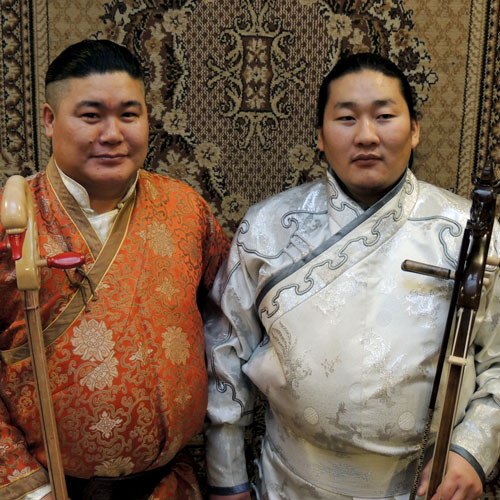Tsogtgerel Tserendavaa and Ganzorig Nergui represent two distinct practices of khöömii, overtone singing tradition in Mongolia. If Tsogtgerel knew assimilating the tradition of the Altai steppes to the academic model of Ulaanbaatar, through a very powerful overtone singing with a large harmonic register, self-taught Ganzorig perfectly combines the Tuvinian and Mongolian styles. Besides khöömii, Tsogtgerel and Ganzorig both perform praise song magtaal and throat singing shakhmal khooloi in overtone singing. They also play horse head fiddle morin khuur, lute tovshuur and mouth harps.
—
References:
In duo: Musée de la Castre, Cannes, Musée de Bibracte
With the ensemble Voix-Nomades Sardaigne-Mongolie: Fes Festival of World Sacred Music, Les Orientales Festival, Les Détours de Babel Festival, Ravenna Festival, Førde Folk Music Festival, Crossroads Festival…
Biographies
Tsogtgerel Tserendavaa
Born in 1990, year of the horse in Chandmani district in Khovd province, Tsogtgerel lives in Ulaanbaatar. He started learning khöömii when he was 13 years old, from his father Tserendavaa in the pastoral life. Moving from 5 to 6 times a year between the Mount Jargalant Khairkhan and Khar-Us lake and keeping the family herd, Tsogtgerel listened and imitated his father and gradually mastered his overtone techniques. At the age of 16, Tsogtgerel was sent by his father to the University of Culture and Arts in Ulaanbaatar to learn khöömii with another master, Odsuren Baatar. Tserendavaa wanted his son to go beyond enriching what he learnt from him, but above all, to get a professional degree of overtone singer to ensure himself a good career.
Tsogtgerel also plays horse head fiddle morin khuur, flute tsuur, lute tovshuur and mouth harp tumur khuur. He first learnt the fiddle with his father, and then with Duvchin, one of the last teachers kept the Western style of play of this instrument in Mongolia. Tsogtgerel currently works as an overtone singer at Mongolian National Song and Dance Academic Ensemble in Ulaanbaatar. Despite his intense soloist activity, he is regularly invited in Inner Mongolia (China) to teach khöömii.
Discography Tsogtgerel
- Tserendavaa et Tsogtgerel : Chant diphonique de l’Altaï mongol (N01, Coulaines: Routes Nomades, exhausted, limited to 400 copies, 2006)
- Tserendavaa & Tsogtgerel, chants diphoniques de l’Altaï mongol (3017742, Paris : Buda Musique, coll. Musiques du monde, 2008)
- Ts. Tsogtgerel, Mongolian Throat Singing (Ulaanbaatar : autoproduction, 2010)
Ganzorig Nergui
Born in 1974, year of tiger in Zuunkharaa town in Selenge province, Ganzorig lives in Ulaanbaatar. When he was a child, he learnt horse head fiddle at school, then self-taught khöömii by listening to the recordings of the famous overtone singers as Sundui and Ganbold on the radio. Having mastered the two principal techniques of overtone singing, he gradually specialized in performing and composing the praise song magtaal. He practices four techniques of khöömi: uruulyn khöömii (labial khöömii), bagalzuuryn khöömii (throat khöömii), khamryn khöömii (nasal khöömii) and kharkhiraa (deep khöömii). He also plays lute tovshuur, horse-head fiddle morin khuur, mouth harp in bamboo khulsan khuur, and flute tsuur.
Ganzorig occasionally works with the ensemble of the Zuunkharaa Theater. He founded Altai-Khangai group in 1996, which led him to play in many countries: four years of residence in Germany, three years in Netherlands, and individual concerts in France, USA, Switzerland, Austria and Morocco. Turned into the musical compositions from traditional elements, Ganzorig brought a number of innovations in the repertory of khöömii. His originality characterizes the perfect combination of Mongolian and Tuvinian overtone singing.
Discography Ganzorig
With Altaï-Khangaï :
- Gone with the wind. Songs of mongolian steppes (WTE CD 002, Amsterdam : Window to Europe, 1998)
- Naariits Bïïlye, Let’s Dance. Mongolian khuuryn tatlaga (PAN 2061, Leiden : Pan Records, Ethnic Series, 1999)
- Melodious Tree (AKA09001, Ulaanbaatar : autoproduction, 2000)
- Naadam (Ulaanbaatar : autoproduction, 2006)
- Öngöd (COTE Paris : Buda Musique/Full Rhizome, 2013)
With Dörvön Berkh:
- Dörvön Berkh, Four Shagai Bones, Masters of Mongolian Overtone Singing (PAN 2100, Leiden : Pan Records, Ethnic Series, 2010)
Self-production:
- Khuumei, magtaalchi Ganzorig N. (Ulaanbaatar: Self-production, 2014)
—
Text: Johanni Curtet

